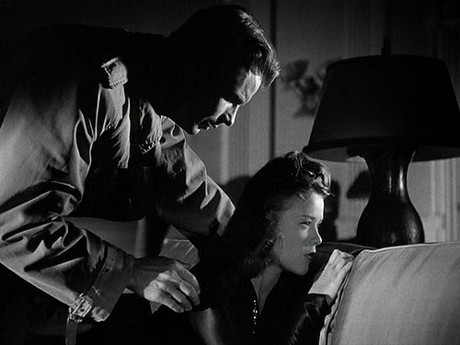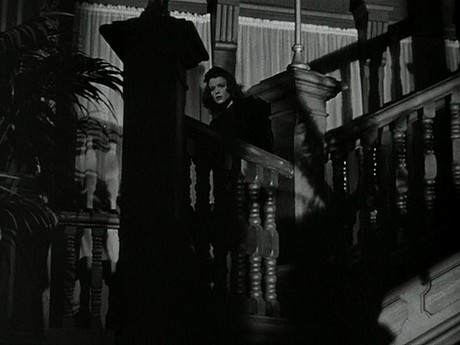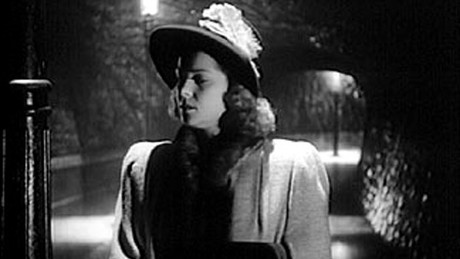Hey guys! Horrorella here...
Welcome back to Celluloid Nightmares! This week I am diving into the shadowy and minimalist world of acclaimed horror producer Val Lewton with a long overdue viewing of CAT PEOPLE.

Written by DeWitt Bodeen (based on a short story by Lewton) and directed by Jacques Tourneur, the film opens with a young couple, Irena (Simone Simon) and Oliver (Kent Smith) falling in love and marrying. At first, theirs is an idyllic, happy relationship, and it seems a foregone conclusion that they will live happily ever after.
As fairytale as it all starts out, no relationship is without its problems, and the issues this couple will be dealing with are in a world of their own. Irena holds some strange beliefs about her ancestry. She believes herself to be descended from a group of cat people from Serbian folklore, who were driven into the mountains after practicing satanic rituals, and that she herself will turn into a large, dangerous cat if she succumbs to sexual desire or is unduly angered. The belief frightens her quite a bit, and naturally begins to cause problems in the couple's relationship.
Oliver insists she seek the help of Dr. Judd (Tom Conway), a psychiatrist, to help her to deal with her unfounded ideas. The doctor tries to help her to see that these beliefs are simply the result of childhood trauma and have no basis in reality. But try thought he might, Irena is locked into these notions, fearful that the wrong move could break the tenuous happiness that she has enjoyed in her marriage.

Making matters worse, as the couple struggles, Irena sees Oliver growing closer to his coworker, Alice (Jane Randolph). As the bond between the two of them strengthens, Irena’s jealousy grows, pulling her and Oliver further apart and leaving Irena feeling vulnerable and isolated. She begins exhibiting predatory behavior, following Alice at several different points in the film, becoming generally more intimidating as she begins to feel threatened.
As the story progresses, it introduces more and more evidence supporting the case that the legend of Irena's ancestry isn't simply a wild delusion. There are several fantastic scenes that hint at the presence of a large cat, but it stays in the shadows and we never get a proper look at it, which is a tremendously effective storytelling technique. CAT PEOPLE doesn't rely on more traditional horror tactics of the day, and instead, Lewton creates a darker, more psychological landscape for the film. Shadows, dark corners and the unseen prove just as effective here as the monsters that had populated Universal's film slate for the decade prior. This film relies heavily on creating a monster in the minds of the audience, rather than presenting a monster onscreen.

One particularly memorable example involves Alice walking down a deserted street at night, followed at a distance by Irena. The film cuts back and forth between the two women - Alice gradually walks faster, glimpsing behind her every so often as she begins to grow aware of a constant presence. She is followed by Irena, walking calmly, just out of sight. The tension mounts as Alice darts from streetlight to streetlight, gazing at the shadows around her in an attempt to catch a glimpse of her pursuer. When we are convinced that Irena is about to make her move, a bus suddenly pulls up in front of Alice, startling both her and the audience, and offering a reprieve*. As Alice boards the bus and it pulls away, we see the trees behind where she stood begin to shake violently, hinting not only at the potential supernatural villain that was close at-hand, but also letting us know just how close Alice came to real danger.

Horror elements aside, the film is also fascinating as an examination of relationships, featuring a healthy and well-balanced partnership. Oliver and Irena start out as a well-functioning couple - kind, caring, affectionate. From the beginning, they have a strong and positive relationship. Reciprocal and open, sharing their thoughts and feelings about their lives. When Irena communicates her fears to Oliver, he doesn't blow them off or laugh them away the way you might expect from a male partner in the 1940's. There is no conveyance of "my ridiculous wife" or "the silly woman" in this story. Though he feels her fears are unfounded, he accepts them with an appropriate amount of respect, and instead of chiding Irena, encourages her to get the proper help.
The performances are all solid, particularly from Simone Simon. She perfectly captures the various stages that Irena goes through over the course of the film, allowing her to be vulnerable and lost in the beginning, as she assumes the worst and fears herself a doomed woman, to later in the film, when the jealous and wounded characteristics begin to take over, and she embodies embody the more animalistic side of her persona. Though we don't see much of the big cat that she believes herself capable of becoming, we do see its hunter instincts begin to take hold and display themselves in her behavior and in her personality. It is through this that Irena slowly transforms from heroine into monster, in the eyes of the audience. We feel for her every step of the way, but there is decidedly a point at which we are no longer seeing her as the hero of the story, and we instead begin to fear for the well-being of Alice and Oliver.
CAT PEOPLE received mixed reviews upon its initial release, but has since gone on to become one of horror's undisputed classics. Lewton's method of employing the power of suggestion and providing a minimalist approach was studied for years to come, and has absolutely left a mark on cinema. CAT PEOPLE is a stunningly eerie film that balances character development with atmosphere and tension, creating a story that is as engaging as it is suspenseful.
*This has since become known as the Lewton Bus, and is a staple trope of horror cinema - allowing a suspenseful scene to progress to the breaking point before introducing a startling, yet benign element into the scene to break that tension
